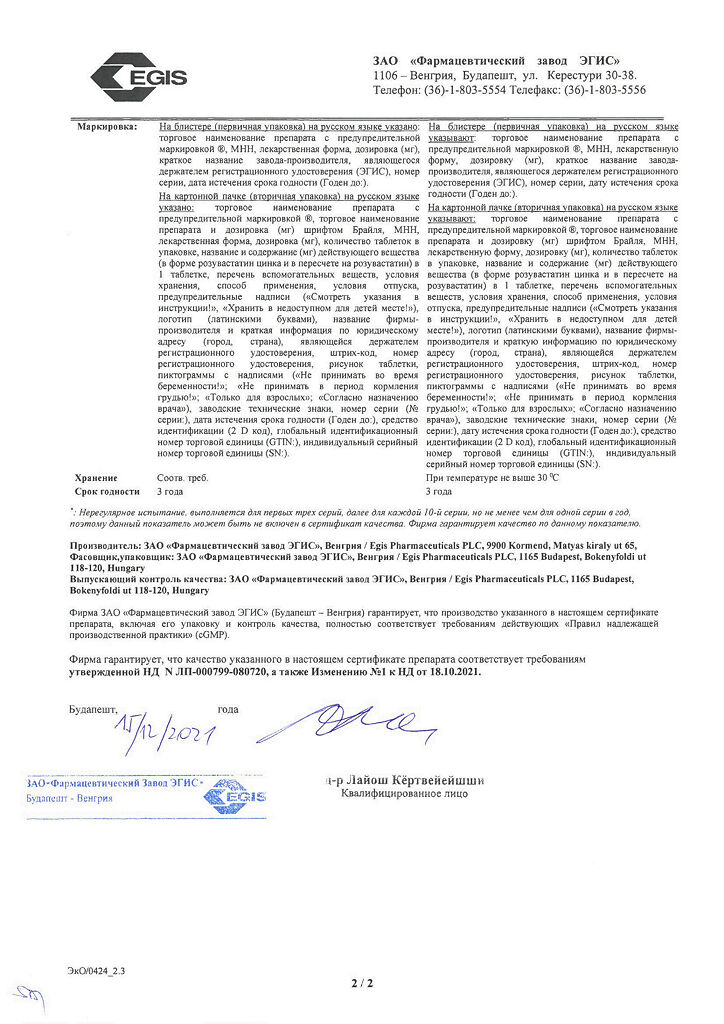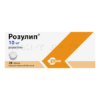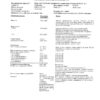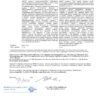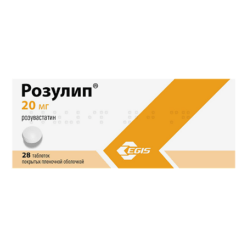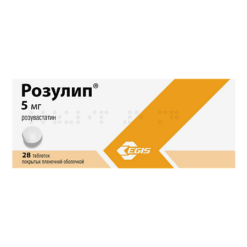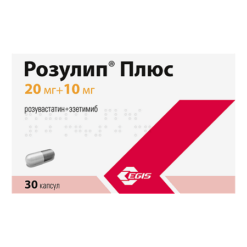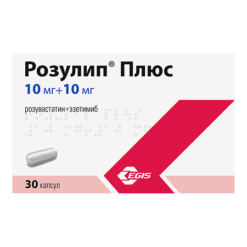No products in the cart.
Rosulip, 10 mg 28 pcs.
€27.35 €23.71
Description
Pharmacotherapeutic group:
hypolipidemic agent – HMG-CoA reductase inhibitor.
ATC code: C10AA07
Pharmacological properties
Mechanism of action
Rosuvastatin is a selective, competitive inhibitor of 3-hydroxy-3-methylglutaryl coenzyme A (HMG-CoA) reductase, the enzyme that converts HMG-CoA to mevalonate, a precursor of cholesterol (CH). The main target of rosuvastatin action is the liver, where it synthesizes cholesterol and catabolizes low-density lipoproteins (LDL).
Rosuvastatin increases the number of “hepatic” LDL receptors on the surface of liver cells, increasing capture and catabolism of LDL, which in turn leads to inhibition of synthesis of very low density lipoproteins (VLDL), thereby reducing the total amount of LDL and LDL.
Pharmacodynamics
. Rosuvastatin reduces elevated concentrations of LDL-C, total cholesterol and triglycerides (TG), increases concentrations of high-density lipoprotein cholesterol (HDL-C), and decreases concentrations of apolipoprotein B (Apo B), low-density lipoprotein cholesterol (Non-LDL), HDL-C, TG-LDL-C, and increases apolipoprotein A-I concentration (Apo A-I) (see Tables 1 and 2). Tables 1 and 2), decreases the ratio of LDL-C/HC-LDL, total CH/LDL and non-LDL-C/HC-LDL and the apo B/Apo A-I ratio.
Therapeutic effect develops within one week after the start of treatment. Within 2 weeks of therapy, efficacy reaches a level that is 90% of the maximum possible. Maximum therapeutic effect is usually reached by the 4th week of therapy and is maintained with regular use of the drug.
Table 1. Dose-dependent effect in patients with primary hypercholesterolemia (type ΙΙa and ΙΙb according to Fredrickson classification) (mean adjusted percentage change from baseline).
Dose | Number of patients | LDL-C | Total HC | HDL-C | TG | HC non-HDLVP | Apo B | Apo A-Ι | ||
Placebo | 13 | -7 | -5 < | 3 | -3 | -7 | -3 | 0 | ||
10 mg | 17 | -52 |
14 | -10 | -48 | -42 | 4 | |||
20 mg | 17 | -55 | -40 | 8 | -23 | -51 | -46 | 5 | ||
40 mg | 18 | -63 | -46 | 10 | -28 | -60 | -54 | 0 |
Table 2. Dose-dependent effect in patients with hypertriglyceridemia (type ΙΙb and ΙV according to Fredrickson classification) (mean percentage change from baseline).
Dose | Number of patients | TG | LDL-C | Total HC | HDL cholesterol | non-HDL cholesterol | HDL-C | TG-LDLNP | |
Placebo | 26 | 1 | 5 | 1 | -3 | 2 | 2 | 6 | |
10 mg | 23 | -37 | -45 | -40 | 8 | -49 | -48 | -39 | |
20 mg | 27 | -37 | -31 | -34 | 22 < | -43 | -49 | -40 | |
40 mg | 25 | -43 | -43 | -40 | 17 | -51 | -56 |
Clinical effectiveness
Rosuvastatin is effective in adult patients with hypercholesterolemia with or without hypertriglyceridemia, regardless of race, sex, or age, including patients with diabetes and familial hypercholesterolemia.
In 80% of patients with hypercholesterolemia of IIa and IIb types by Fredrickson classification (mean baseline concentration of LDL-C about 4.8 mmol/l) during the drug treatment in dose of 10 mg LDL-C concentration reaches values less than 3 mmol/l.
In patients with homozygous familial hypercholesterolemia taking rosuvastatin in doses of 20 mg and 40 mg, the mean decrease in LDL-C concentration is 22%.
Patients with hypertriglyceridemia with initial TG concentrations of 273 to 817 mg/dL who received rosuvastatin in doses of 5 mg to 40 mg once daily for 6 weeks had significantly reduced plasma TG concentrations (see Table 2).
Additive effect is noted in combination with fenofibrate for TG concentration and with nicotinic acid in lipid-lowering doses for HDL-C concentration (see also section “Special indications”).
Pharmacokinetics
Absorption and distribution
Maximum plasma concentration of rosuvastatin (Cmax) is reached approximately 5 hours after oral administration. Absolute bioavailability is approximately 20%.
Rosuvastatin is metabolized primarily by the liver, which is the main site of CH synthesis and metabolism of LDL-C. The volume of distribution (Vd) of rosuvastatin is approximately 134 L. Approximately 90% of rosuvastatin is bound to plasma proteins, mainly to albumin.
Metabolism
Subject to limited metabolism (about 10%). Rosuvastatin is a non-core substrate for metabolism by isoenzymes of cytochrome P450 system. The main isoenzyme involved in metabolism of rosuvastatin is CYP2C9 isoenzyme. CYP2C19, CYP3A4 and CYP2D6 isoenzymes are less involved in metabolism.
The main identified metabolites of rosuvastatin are N-desmethylrosuvastatin and lactone metabolites. N-desmethylrosuvastatin is approximately 50% less active than rosuvastatin, lactone metabolites are pharmacologically inactive. More than 90% of the pharmacological activity for inhibition of circulating HMG-CoA reductase is provided by rosuvastatin, the rest by its metabolites.
Excretion
About 90% of the dose of rosuvastatin is excreted unchanged through the intestine (including absorbed and unabsorbed rosuvastatin). The remainder is excreted by the kidneys. Plasma elimination half-life (T1/2) is approximately 19 hours. T1/2 does not change with increasing drug dose. Mean geometric plasma clearance is approximately 50 L/hour (coefficient of variation 21.7%). As in the case of other HMG-CoA reductase inhibitors, hepatic uptake of rosuvastatin involves membrane cholesterol transporter, which plays an important role in hepatic elimination of rosuvastatin.
Linearity
Systemic exposure of rosuvastatin increases in proportion to the dose. Pharmacokinetic parameters do not change with daily administration.
Special patient populations.
Age and sex
Gender and age have no clinically significant effect on the pharmacokinetics of rosuvastatin.
Ethnic groups
Pharmacokinetic studies have shown an approximately twofold increase in median area under the concentration-time curve (AUC) and Cmax rosuvastatin in patients of Asian origin (Japanese, Chinese, Filipinos, Vietnamese and Koreans) compared to Europeans; a 1.3-fold increase in median AUC and Cmax was shown in Indian patients. Pharmacokinetic analysis showed no clinically significant differences in pharmacokinetics among Europeans and members of the Negro race.
Renal failure
In patients with mild to moderately severe renal failure the plasma concentration of rosuvastatin or N-desmethylrosuvastatin does not change significantly. In patients with severe renal insufficiency (creatinine clearance (CK) < 30 ml/min) the plasma concentration of rosuvastatin is 3 times higher, and N-desmethylrosuvastatin concentration is 9 times higher than in healthy volunteers. Plasma concentrations of rosuvastatin were approximately 50% higher in patients on hemodialysis than in healthy volunteers.
Liver failure
No increase in T1/2 rosuvastatin was detected in patients with various stages of liver failure (with a Child-Pugh score of 7 or lower). Two patients with Child-Pugh scores of 8 and 9 showed at least a 2-fold increase in T1/2. There is no experience with rosuvastatin in patients with a Child-Pugh score above 9.
Genetic polymorphism
. HMG-CoA reductase inhibitors, including rosuvastatin , bind to the transport proteins OATP1B1 (organic anion transport polypeptide involved in the capture of statins by hepatocytes) and BCRP (efflux transporter). Carriers of SLCO1B1 (OATP1B1) c.521CC and ABCG2 (BCRP) c.421AA genotypes had 1.6 and 2.4-fold increased exposure (AUC) to rosuvastatin, respectively, compared with carriers of SLCO1B1 c.521TT and ABCG2 c.421CC genotypes.
Indications
Indications
homozygous hereditary hypercholesterolemia, as an adjunct to diet and other treatments aimed at lowering blood lipid levels (eg LDL apheresis), and also in cases where these methods are not effective enough;
to slow the progression of atherosclerosis, as a supplement to the diet in patients, incl. who are indicated for therapy to reduce the level of total cholesterol and LDL cholesterol;
primary hypercholesterolemia (Fredrickson type IIa) or mixed hypercholesterolemia (type IIb), as an addition to diet, when diet and other non-drug treatments (eg exercise, weight loss) are insufficient;
hypertriglyceridemia (Fredrickson type IV), as an adjunct to diet;
prevention of major cardiovascular complications (stroke, myocardial infarction, arterial revascularization) in adult patients without clinical signs of coronary heart disease, but with an increased risk of its development (age over 50 years for men and over 60 years for women, increased concentration of C-reactive protein (≥2 mg/l) in the presence of at least one of the additional risk factors, such as arterial hypertension, low HDL-C concentration, smoking, family history of early onset coronary heart disease.
Pharmacological effect
Pharmacological effect
Pharmacotherapeutic group:
lipid-lowering agent – HMG-CoA reductase inhibitor.
ATX code: C10AA07
PHARMACOLOGICAL PROPERTIES
Mechanism of action
Rosuvastatin is a selective, competitive inhibitor of 3-hydroxy-3-methylglutaryl coenzyme A (HMG-CoA) reductase, an enzyme that converts HMG-CoA to mevalonate, a precursor of cholesterol (C). The main target of action of rosuvastatin is the liver, where cholesterol synthesis and catabolism of low-density lipoproteins (LDL) take place.
Rosuvastatin increases the number of “liver” LDL receptors on the surface of liver cells, increasing the uptake and catabolism of LDL, which in turn leads to inhibition of very low-density lipoprotein (VLDL) synthesis, thereby reducing the total amount of LDL and VLDL.
Pharmacodynamics
Rosuvastatin reduces elevated concentrations of LDL-C, total cholesterol and triglycerides (TG), increases the concentration of high-density lipoprotein-C (HDL-C), and also reduces the concentration of apolipoprotein B (Apo B), low-density lipoprotein cholesterol (non-HDL-C), VLDL-C, VLDL-TG and increases the concentration of apolipoprotein A-I (Apo A-I) (see tables 1 and 2), reduces the ratio of LDL-C/HDL-C, total cholesterol/HDL-C and non-HDL-C/HDL-C and the Apo B/Apo A-I ratio.
The therapeutic effect develops within one week after the start of treatment. Within 2 weeks of therapy, the effectiveness reaches a level that is 90% of the maximum possible. The maximum therapeutic effect is usually achieved by the 4th week of therapy and is maintained with regular use of the drug.
Table 1. Dose response in patients with primary hypercholesterolemia (Fredrickson type ΙΙa and ΙΙb) (mean adjusted percentage change from baseline).
Dose
Number of patients
LDL-C
General HS
HDL-C
TG
Non-HDL cholesterol
Apo B
Apo A-Ι
Placebo
13
-7
-5
3
-3
-7
-3
0
10 mg
17
-52
-36
14
-10
-48
-42
4
20 mg
17
-55
-40
8
-23
-51
-46
5
40 mg
18
-63
-46
10
-28
-60
-54
0
Table 2. Dose response in patients with hypertriglyceridemia (Fredrickson type ΙΙb and ΙV) (mean percentage change from baseline).
Dose
Number of patients
TG
LDL-C
General HS
HDL-C
Non-HDL cholesterol
VLDL-C
TG-VLDL
Placebo
26
1
5
1
-3
2
2
6
10 mg
23
-37
-45
-40
8
-49
-48
-39
20 mg
27
-37
-31
-34
22
-43
-49
-40
40 mg
25
-43
-43
-40
17
-51
-56
-48
Clinical effectiveness
Rosuvastatin is effective in adult patients with hypercholesterolemia with or without hypertriglyceridemia, regardless of race, gender or age, including patients with diabetes mellitus and familial hypercholesterolemia.
In 80% of patients with type IIa and IIb hypercholesterolemia according to the Fredrickson classification (the average initial concentration of LDL-C is about 4.8 mmol/l), when taking the drug at a dose of 10 mg, the concentration of LDL-C reaches values of less than 3 mmol/L.
In patients with homozygous familial hypercholesterolemia taking rosuvastatin 20 mg and 40 mg, the average reduction in LDL-C concentrations is 22%.
In patients with hypertriglyceridemia with an initial TG concentration of 273 to 817 mg/dL who received rosuvastatin at a dose of 5 mg to 40 mg once daily for 6 weeks, the concentration of TG in the blood plasma was significantly reduced (see Table 2).
An additive effect is observed in combination with fenofibrate in relation to the concentration of TG and with nicotinic acid in lipid-lowering doses in relation to the concentration of HDL-C (see also section “Special instructions”).
Pharmacokinetics
Absorption and distribution
The maximum plasma concentration of rosuvastatin (Cmax) is achieved approximately 5 hours after oral administration. Absolute bioavailability is approximately 20%.
Rosuvastatin is metabolized primarily by the liver, which is the main site of cholesterol synthesis and LDL-C metabolism. The volume of distribution (Vd) of rosuvastatin is approximately 134 L. Approximately 90% of rosuvastatin is bound to plasma proteins, mainly albumin.
Metabolism
Subject to limited metabolism (about 10%). Rosuvastatin is a non-core substrate for metabolism by isoenzymes of the cytochrome P450 system. The main isoenzyme involved in the metabolism of rosuvastatin is the CYP2C9 isoenzyme. Isoenzymes CYP2C19, CYP3A4 and CYP2D6 are involved in metabolism to a lesser extent.
The main identified metabolites of rosuvastatin are N-desmethyl rosuvastatin and lactone metabolites. N-desmethyl rosuvastatin is approximately 50% less active than rosuvastatin; lactone metabolites are pharmacologically inactive. More than 90% of the pharmacological activity of inhibiting circulating HMG-CoA reductase is provided by rosuvastatin, the rest by its metabolites.
Removal
About 90% of the dose of rosuvastatin is excreted unchanged through the intestine (including absorbed and unabsorbed rosuvastatin). The remaining part is excreted by the kidneys. The plasma half-life (T1/2) is approximately 19 hours. T1/2 does not change with increasing dose of the drug. The geometric mean plasma clearance is approximately 50 L/h (coefficient of variation 21.7%). As in the case of other HMG-CoA reductase inhibitors, the process of “hepatic” uptake of rosuvastatin involves a membrane cholesterol transporter, which plays an important role in the hepatic elimination of rosuvastatin.
Linearity
Systemic exposure of rosuvastatin increases in proportion to the dose. Pharmacokinetic parameters do not change with daily use.
Special patient populations.
Age and gender
Gender and age do not have a clinically significant effect on the pharmacokinetics of rosuvastatin.
Ethnic groups
Pharmacokinetic studies have shown an approximately two-fold increase in the median area under the concentration-time curve (AUC) and Cmax of rosuvastatin in patients of Asian origin (Japanese, Chinese, Filipinos, Vietnamese and Koreans) compared with Europeans; Indian patients showed a 1.3-fold increase in median AUC and Cmax. Pharmacokinetic analysis did not reveal clinically significant differences in pharmacokinetics between Europeans and blacks.
Kidney failure
In patients with mild to moderate renal failure, the plasma concentration of rosuvastatin or N-desmethylrosuvastatin does not change significantly. In patients with severe renal failure (creatinine clearance (CC) <30 ml/min.), the concentration of rosuvastatin in the blood plasma is 3 times higher, and the concentration of N-desmethylrosuvastatin is 9 times higher than in healthy volunteers. Plasma concentrations of rosuvastatin in hemodialysis patients were approximately 50% higher than in healthy volunteers.
Liver failure
In patients with various stages of liver failure (with a score of 7 and below on the Child-Pugh scale), an increase in T1/2 of rosuvastatin was not detected. In two patients with scores of 8 and 9 on the Child-Pugh scale, an increase in T1/2 by at least 2 times was noted. There is no experience with the use of rosuvastatin in patients with a score above 9 on the Child-Pugh scale.
Genetic polymorphism
HMG-CoA reductase inhibitors, including rosuvastatin, bind to the transport proteins OATP1B1 (organic anion transport polypeptide involved in the uptake of statins by hepatocytes) and BCRP (efflux transporter). Carriers of the SLCO1B1 (OATP1B1) c.521CC and ABCG2 (BCRP) c.421AA genotypes had an increase in rosuvastatin exposure (AUC) by 1.6 and 2.4 times, respectively, compared with carriers of the SLCO1B1 c.521TT and ABCG2 c.421CC genotypes.
Special instructions
Special instructions
Renal effects
In patients receiving high doses of rosuvastatin (mainly 40 mg), tubular proteinuria was observed, which in most cases was transient. This proteinuria did not indicate acute kidney disease or progression of kidney disease. In patients taking the drug at a dose of 40 mg, it is recommended to monitor renal function parameters during treatment.
From the musculoskeletal system
The following effects on the musculoskeletal system have been reported with the use of rosuvastatin in all dosages and, in particular, when taking doses of the drug exceeding 20 mg: myalgia, myopathy, and in rare cases, rhabdomyolysis.
Determination of CPK activity
Determination of CPK activity should not be carried out after intense physical activity or in the presence of other possible reasons for increased CPK activity, which may lead to incorrect interpretation of the results obtained. If the initial CPK activity is significantly increased (>5x ULN), a repeat measurement should be performed after 5–7 days. Therapy should not be started if a repeat test confirms initial CPK activity (>5x ULN).
Before starting therapy
When prescribing Rozulip®, as well as when prescribing other HMG-CoA reductase inhibitors, caution should be exercised in patients with existing risk factors for myopathy/rhabdomyolysis (see section “With caution”), the balance of risk and possible benefit of therapy should be considered and clinical observation should be carried out.
During therapy
The patient should be informed to immediately report to the doctor the unexpected onset of muscle pain, muscle weakness or cramps, especially in combination with malaise and fever. In such patients, CPK activity should be determined. Therapy should be discontinued if CPK activity is significantly increased (>5x ULN) or if muscle symptoms are severe and cause daily discomfort (even if CPK activity is not increased >5x ULN). If symptoms disappear and CPK activity returns to normal, re-prescribing Rozulip® or other HMG-CoA reductase inhibitors in lower doses should be considered with careful monitoring of the patient.
Routine monitoring of CPK activity in the absence of symptoms is impractical.
Very rare cases of immune-mediated necrotizing myopathy have been reported with clinical manifestations of persistent proximal muscle weakness and increased serum CPK activity during treatment or upon discontinuation of statins, including rosuvastatin. Additional studies of the muscular and nervous system, serological studies, and therapy with immunosuppressive drugs may be required.
There were no signs of increased effects on skeletal muscles when taking rosuvastatin and concomitant therapy. However, an increased incidence of myositis and myopathy has been reported in patients taking other HMG-CoA reductase inhibitors in combination with fibric acid derivatives, including gemfibrozil, cyclosporine, nicotinic acid in lipid-lowering doses (more than 1 g/day), azole antifungals, HIV protease inhibitors and macrolide antibiotics. Gemfibrozil increases the risk of myopathy when combined with certain HMG-CoA reductase inhibitors. Thus, simultaneous administration of Rozulip® and gemfibrozil is not recommended. The risk/benefit ratio should be carefully weighed when using Rozulip® together with fibrates or lipid-lowering doses of nicotinic acid. Taking Rozulip® at a dose of 40 mg together with fibrates is contraindicated (see sections “Interaction with other drugs”, “Contraindications”).
2-4 weeks after the start of treatment and/or when increasing the dose of the drug Rozulip®, monitoring of lipid metabolism parameters is necessary (if necessary, dose adjustment is required).
Liver
It is recommended to determine liver function indicators before starting therapy and 3 months after starting therapy. Taking Rozulip® should be stopped or the dose reduced if the activity of “liver” transaminases in the blood serum is > 3x ULN.
In patients with hypercholesterolemia due to hypothyroidism or nephrotic syndrome, treatment of underlying diseases should be carried out before starting treatment with Rozulip®.
Special populations. Ethnic groups
During pharmacokinetic studies among Chinese and Japanese patients, an increase in systemic concentrations of rosuvastatin was noted compared with values obtained among European patients (see sections “Dosage and Administration” and “Pharmacokinetics”).
HIV protease inhibitors
Concomitant use of the drug with HIV protease inhibitors is not recommended (see section “Interaction with other drugs”).
Lactose
The drug should not be used in patients with lactase deficiency, galactose intolerance and glucose-galactose malabsorption.
Interstitial lung disease
Isolated cases of interstitial lung disease have been reported with some statins, especially over long periods of use. Manifestations of the disease may include shortness of breath, nonproductive cough and deterioration in general health (weakness, weight loss and fever). If interstitial lung disease is suspected, statin therapy should be discontinued.
Diabetes mellitus type 2
In patients with glucose concentrations between 5.6 and 6.9 mmol/L, rosuvastatin therapy was associated with an increased risk of developing type 2 diabetes mellitus.
Application in pediatric practice
The effectiveness and safety of Rozulip® in children under 18 years of age has not yet been established, therefore the use of this drug is contraindicated in patients of this age group.
INFLUENCE ON THE ABILITY TO DRIVE VEHICLES AND MECHANISMS
There have been no studies examining the effect of rosuvastatin on the ability to drive and use machinery. However, based on pharmacodynamic properties, rosuvastatin should not have such an effect. Caution should be exercised when driving a vehicle or doing work that requires increased concentration and psychomotor reaction (dizziness may occur during therapy).
Active ingredient
Active ingredient
Rosuvastatin
Composition
Composition
Active ingredient:
each tablet contains 5 mg, 10 mg, 20 mg or 40 mg
rosuvastatin (in the form, respectively: 5.34 / 10.68 / 21.36 / 42.72 mg rosuvastatin zinc).
Excipients:
ludipress 65.16 / 130.32 / 260.64 / 521.28 mg [(lactose monohydrate (93%), povidone (3.5%), crospovidone (3.5%)],
crospovidone 3.75/ 7.50/ 15.00/ 30.00 mg,
magnesium stearate 0.75 / 1.50 / 3.00 / 6.00 mg;
shell:
opadry II white 85F 18422 1.90 / 3.80 / 7.50 / 15.00 mg [polyvinyl alcohol (40%), titanium dioxide (25%), macrogol 3350 (20.2%), talc (14.8%)].
Pregnancy
Pregnancy
Rozulip is contraindicated during pregnancy and lactation (breastfeeding). If pregnancy is diagnosed during therapy, the drug should be discontinued immediately.
Women of reproductive age should use adequate methods of contraception. Since cholesterol and its biosynthesis products are important for fetal development, the potential risk of inhibiting HMG-CoA reductase outweighs the benefits of using the drug.
There is no data on the excretion of rosuvastatin in breast milk, therefore, if it is necessary to use the drug during lactation, breastfeeding should be discontinued.
Contraindications
Contraindications
hypersensitivity to rosuvastatin and any of the excipients of the drug;
active liver disease, including a persistent increase in serum transaminase activity and any increase in serum transaminase activity (> 3 x upper limit of normal (ULN);
severe renal dysfunction (creatinine clearance <30 ml/min);
myopathy;
simultaneous use of cyclosporine;
in women: pregnancy, breastfeeding, as well as the lack of adequate methods of contraception in women with preserved reproductive function;
patients predisposed to the development of myotoxic complications;
children under 18 years of age (due to the lack of sufficient clinical data, efficacy and safety have not been established, see section “Special Instructions”);
lactose intolerance, lactase deficiency or glucose-galactose malabsorption (the drug contains lactose).
With caution
There is a risk of developing myopathy/rhabdomyolysis – renal failure, hypothyroidism, personal or family history of hereditary muscle diseases and a previous history of muscle toxicity when using other HMG-CoA reductase inhibitors or fibrates; excessive alcohol consumption; age over 65 years; conditions in which an increase in plasma concentration of rosuvastatin is noted; race (Asian race); simultaneous use with fibrates (see section “Pharmacokinetics”); history of liver disease, sepsis; arterial hypotension; major surgery, trauma, severe metabolic, endocrine or electrolyte disturbances, or uncontrolled seizures.
Side Effects
Side Effects
Side effects observed when taking Rozulip® are usually mild and go away on their own. As with other HMG-CoA reductase inhibitors, the incidence of side effects is mainly dose-dependent.
The frequency of occurrence of undesirable effects is presented as follows:
often (> 1/100, 1/1000, 1/10000, < 1/1000); very rare (< 1/10000), unspecified frequency (cannot be calculated from the available data).
Immune system
Rare: hypersensitivity reactions, including angioedema
Endocrine system
Common: type 2 diabetes mellitus
From the central nervous system (CNS)
Common: headache, dizziness
From the digestive tract
Common: constipation, nausea, abdominal pain
Rare: pancreatitis
From the skin
Uncommon: pruritus, skin rash, urticaria
From the musculoskeletal system
Common: myalgia
Rare: myopathy (including myositis), rhabdomyolysis
Others
Common: asthenic syndrome
From the urinary system
Proteinuria may be detected in patients receiving rosuvastatin. Changes in the amount of protein in the urine (from none or trace amounts to ++ or more) are observed in less than 1% of patients receiving 10 – 20 mg of the drug. A slight change in the amount of protein in the urine was noted when taking a dose of 20 mg. In most cases, proteinuria decreases or disappears during therapy and does not indicate the onset of acute or progression of existing kidney disease.
From the musculoskeletal system
The following effects on the musculoskeletal system have been reported with the use of rosuvastatin at all doses and, in particular, when taking doses of the drug exceeding 20 mg: myalgia, myopathy (including myositis), in rare cases, rhabdomyolysis with or without acute renal failure.
A dose-dependent increase in creatine phosphokinase (CPK) activity is observed in a small number of patients taking rosuvastatin. In most cases it was minor, asymptomatic and temporary. In case of increased CPK activity (>5x ULN), therapy should be suspended (see section “Special Instructions”).
From the liver
When using rosuvastatin, a dose-dependent increase in the activity of “liver” transaminases is observed in a small number of patients. In most cases it is minor, asymptomatic and temporary.
Laboratory indicators
When using rosuvastatin, the following changes in laboratory parameters were also observed: increased concentrations of glucose, bilirubin, gamma-glutamyl transpeptidase activity, alkaline phosphatase, thyroid dysfunction.
Post-marketing use
The following side effects have been reported during post-marketing use of rosuvastatin:
From the hematopoietic system
Frequency unknown: thrombocytopenia
From the digestive tract
Very rare: jaundice, hepatitis
Rarely: increased activity of liver transaminases
Frequency unknown: diarrhea
From the musculoskeletal system
Very rare: arthralgia
Not known: immune-mediated necrotizing myopathy
From the side of the central nervous system
Very rare: memory loss or decline
Not known: peripheral neuropathy
From the respiratory system:
Frequency unknown: cough, shortness of breath
From the urinary system
Very rare: hematuria
From the skin and subcutaneous fat
Frequency unknown: Stevens-Johnson syndrome
From the reproductive system and mammary gland
Frequency unknown: gynecomastia
Others
Frequency unknown: peripheral edema
The following side effects have been reported with some statins:
depression, sleep disorders, including insomnia and nightmares, sexual dysfunction. Isolated cases of interstitial lung disease have been reported, especially with long-term use of drugs (see section “Special instructions”).
Interaction
Interaction
The effect of the use of other drugs on rosuvastatin
Transport protein inhibitors: rosuvastatin binds to certain transport proteins, in particular OATP1B1 and BCRP. Concomitant use of drugs that are inhibitors of these transport proteins may be accompanied by an increase in plasma concentrations of rosuvastatin and an increased risk of developing myopathy (see Table 3 and sections “Dosage and Administration” and “Special Instructions”).
Cyclosporine: with simultaneous use of rosuvastatin and cyclosporine, the AUC of rosuvastatin was on average 7 times higher than the value observed in healthy volunteers (see Table 3). Does not affect plasma concentrations of cyclosporine. Rozulip® is contraindicated in patients taking cyclosporine (see section “Contraindications”).
HIV protease inhibitors: Although the exact mechanism of interaction is unknown, coadministration of HIV protease inhibitors may result in a significant increase in exposure to rosuvastatin (see Table 3). A pharmacokinetic study of co-administration of 20 mg rosuvastatin with a combination drug containing two HIV protease inhibitors (400 mg lopinavir/100 mg ritonavir) in healthy volunteers resulted in approximately two-fold and five-fold increases in AUC (0-24)
and Cmax of rosuvastatin, respectively. Therefore, simultaneous use of rosuvastatin and HIV protease inhibitors is not recommended (see sections “Method of administration and dosage”, “Special instructions”, table 3).
Gemfibrozil and other lipid-lowering drugs: combined use of rosuvastatin and gemfibrozil leads to a 2-fold increase in Cmax
and AUC of rosuvastatin (see section “Special instructions”). Based on specific interaction data, a pharmacokinetically significant interaction with fenofibrate is not expected, but a pharmacodynamic interaction is possible.
Gemfibrozil, fenofibrate, other fibrates and lipid-lowering doses of nicotinic acid increased the risk of myopathy when used concomitantly with HMG-CoA reductase inhibitors, possibly due to the fact that they can cause myopathy when used in monotherapy (see section “Special Instructions”). When taking the drug simultaneously with gemfibrozil, fibrates, nicotinic acid in lipid-lowering doses (more than 1 g/day), an initial dose of the drug of 5 mg is recommended for patients; taking a dose of 40 mg is contraindicated when co-administered with fibrates (see sections “Contraindications”, “Dosage and Administration”, “Special Instructions”).
Ezetimibe: Concomitant use of rosuvastatin 10 mg and ezetimibe 10 mg was associated with an increase in rosuvastatin AUC in patients with hypercholesterolemia (see Table 3). An increased risk of side effects due to the pharmacodynamic interaction between Rozulip® and ezetimibe cannot be excluded.
Antacids: simultaneous use of rosuvastatin and antacid suspensions containing magnesium and aluminum hydroxide leads to a decrease in plasma concentrations of rosuvastatin by approximately 50%. This effect is less pronounced if antacids are used 2 hours after taking rosuvastatin. The clinical significance of this interaction has not been studied.
Erythromycin: simultaneous use of rosuvastatin and erythromycin leads to a decrease in AUC of rosuvastatin by 20% and Cmax of rosuvastatin by 30%. This interaction may occur as a result of increased intestinal motility caused by erythromycin.
Cytochrome P450 isoenzymes: results from in vivo and in vitro studies have shown that rosuvastatin is neither an inhibitor nor an inducer of cytochrome P450 isoenzymes. In addition, rosuvastatin is a weak substrate for these isoenzymes. Therefore, interaction of rosuvastatin with other drugs at the metabolic level involving cytochrome P450 isoenzymes is not expected. There was no clinically significant interaction of rosuvastatin with fluconazole (an inhibitor of the CYP2C9 and CYP3A4 isoenzymes) and ketoconazole (an inhibitor of the CYP2A6 and CYP3A4 isoenzymes).
Fusidic acid: No studies have been conducted to study the interaction of rosuvastatin and fusidic acid. As with other statins, there have been post-marketing reports of rhabdomyolysis with co-administration of rosuvastatin and fusidic acid. Patients must be closely monitored. If necessary, it is possible to temporarily stop taking rosuvastatin.
Interactions with drugs that require dose adjustment of rosuvastatin (see Table 3)
The dose of Rozulip® should be adjusted if it is necessary to use it together with drugs that increase exposure to rosuvastatin. You should read the instructions for use of these drugs before prescribing them together with rosuvastatin. If an increase in exposure by 2 times or more is expected, the initial dose of Rozulip®
should be 5 mg once daily. The maximum daily dose of Rozulip® should also be adjusted.
so that the expected exposure to rosuvastatin does not exceed that for a dose of 40 mg taken without the simultaneous administration of drugs that interact with rosuvastatin. For example, the maximum daily dose of Rozulip® when used simultaneously with gemfibrozil is 20 mg (increased exposure by 1.9 times), with ritonavir/atazanavir – 10 mg (increased exposure by 3.1 times).
Table 3. Effect of concomitant therapy on rosuvastatin exposure (AUC, data in descending order) – results of published clinical studies
Companion mode
therapy
Reception mode
rosuvastatin
Change in AUC
rosuvastatin
Cyclosporine 75-200 mg 2 times a day,
6 months
10 mg 1 time per day, 10 days
7.1x magnification
Atazanavir 300 mg/ritonavir 100 mg once a day, 8 days
10 mg once
3.1x magnification
Simeprevir 152 mg once a day, 7 days
10 mg once
2.8x magnification
Lopinavir 400 mg/ritonavir 100 mg 2 times a day, 17 days
20 mg 1 time per day, 7 days
2.1x magnification
Clopidogrel 300 mg (loading dose), then 75 mg after 24 hours
20 mg once
2x magnification
Gemfibrozil 600 mg 2 times a day, 7 days
80 mg once
1.9x magnification
Eltrombopag 75 mg once daily, 10 days
10 mg once
1.6x magnification
Darunavir 600 mg/ritonavir 100 mg 2 times a day, 7 days
10 mg 1 time per day, 7 days
1.5 times magnification
Tipranavir 500 mg/ritonavir 200 mg 2 times a day, 11 days
10 mg once
1.4x magnification
Dronedarone 400 mg 2 times a day.
No data
1.4x magnification
Itraconazole 200 mg once a day, 5 days
10 mg or 80 mg once
1.4x magnification
Ezetimibe 10 mg once a day, 14 days
10 mg once a day, 14 days
1.2 times magnification
Fosamprenavir 700 mg/ritonavir 100 mg 2 times a day, 8 days
10 mg once
No changes
Aleglitazar 0.3 mg, 7 days
40 mg, 7 days
No changes
Silymarin 140 mg 3 times a day, 5 days
10 mg once
No changes
Fenofibrate 67 mg 3 times a day, 7 days
10 mg, 7 days
No changes
Rifampin 450 mg once a day, 7 days
20 mg once
No changes
Ketoconazole 200 mg 2 times a day, 7 days
80 mg once
No changes
Fluconazole 200 mg once a day, 11 days
80 mg once
No changes
Erythromycin 500 mg 4 times a day, 7 days
80 mg once
28% reduction
Baikalin 50 mg 3 times a day, 14 days
20 mg once
47% reduction
The effect of rosuvastatin on other drugs
Vitamin K antagonists: Initiating rosuvastatin therapy or increasing the dose of the drug in patients receiving concomitant vitamin K antagonists (eg, warfarin) may lead to an increase in the International Normalized Ratio (INR). Discontinuation of rosuvastatin or reduction of the drug dose may lead to a decrease in INR. In such cases, INR monitoring is recommended.
Oral contraceptives/hormone replacement therapy: Concomitant use of rosuvastatin and oral contraceptives increases ethinyl estradiol AUC and norgestrel AUC by 26% and 34%, respectively. This increase in plasma concentration should be taken into account when selecting the dose of oral contraceptives. There are no pharmacokinetic data on the simultaneous use of Rozulip® and hormone replacement therapy; therefore, a similar effect cannot be excluded when using this combination. However, this combination was widely used during clinical trials and was well tolerated by patients.
Other medicinal products: No clinically significant interaction between rosuvastatin and digoxin is expected.
Overdose
Overdose
When taking several daily doses simultaneously, the pharmacokinetic parameters of rosuvastatin do not change.
There is no specific treatment for rosuvastatin overdose. In case of overdose, it is recommended to carry out symptomatic and supportive therapy, measures aimed at maintaining the functions of vital organs and systems. Monitoring of liver function and CPK activity is necessary. The effectiveness of hemodialysis is unlikely.
Storage conditions
Storage conditions
Store at a temperature not exceeding 30 oC. Keep the drug out of the reach of children!
Shelf life
Shelf life
3 years
Manufacturer
Manufacturer
EGIS, Hungary
Additional information
| Shelf life | 3 years |
|---|---|
| Conditions of storage | Store at a temperature not exceeding 30 oC. Keep the drug out of reach of children! |
| Manufacturer | EGIS, Hungary |
| Medication form | pills |
| Brand | EGIS |
Other forms…
Related products
Buy Rosulip, 10 mg 28 pcs. with delivery to USA, UK, Europe and over 120 other countries.



